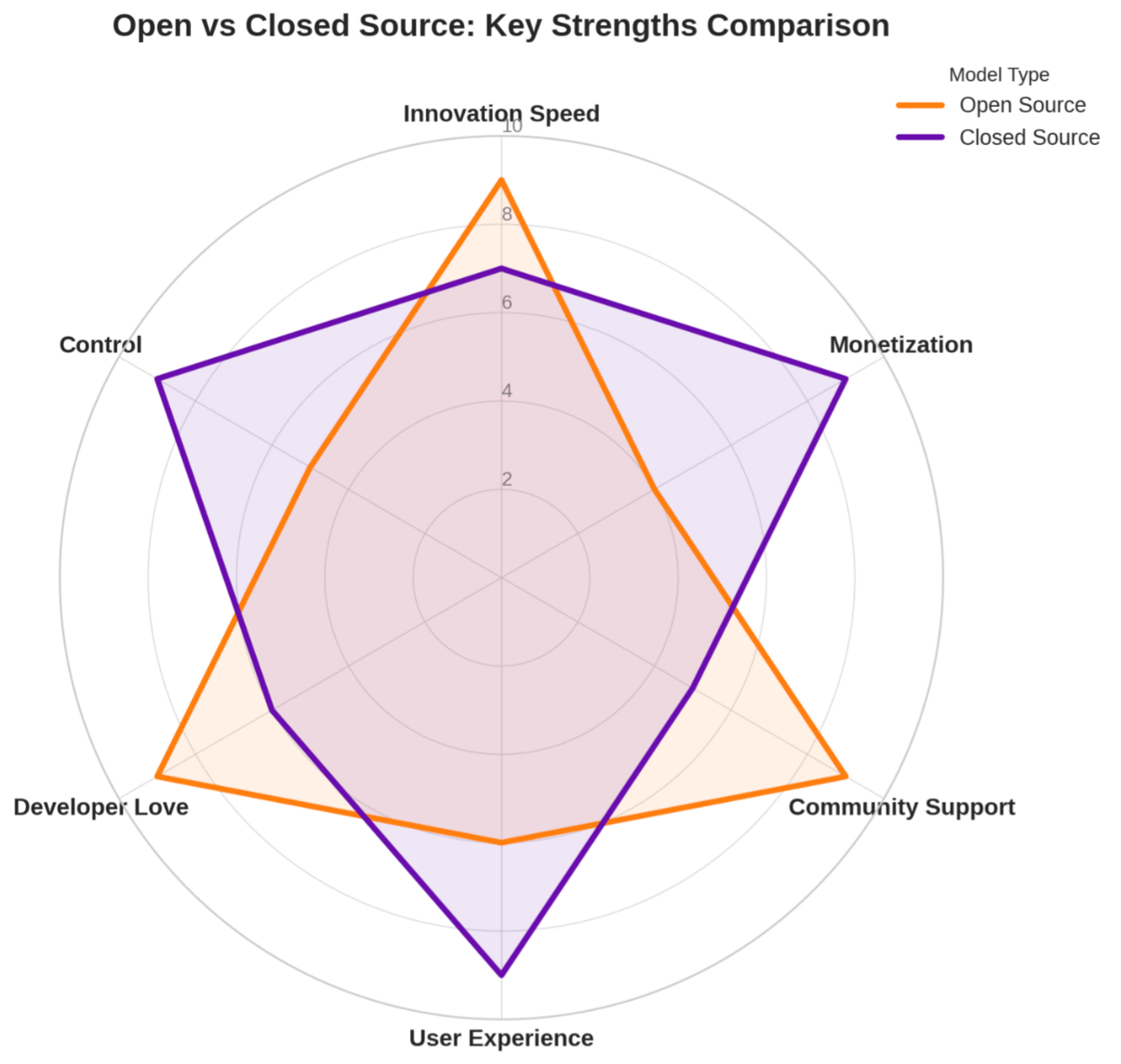
Welcome to another edition of the Neural Net…
It’s Friday, and our algorithms are trying to compute how fast (or slow) this week went by. Time to clear the cache, refresh our energy, and jump into the weekend!
The Great Unlock: How Open Source Is Shaking Up AI

🔓 Open vs. 🔒 Closed: The AI Debate That Actually Affects You
Open vs. closed source tools are a tale as old as time. The core question has always been: how much power should live in the hands of the user? And let’s be real—sometimes, giving full control to users isn’t always the best move. Simplicity, security, and consistency matter.
The radar chart above illustrates the key tradeoffs: open source is flexible, community-driven, and often free. Closed source is polished, easier for most people to use, and often comes at a premium. Neither framework is inherently better—they just serve different purposes.
💥 Why This Matters Now
China is flooding the AI market with open-source tools. Tech giants like Baidu, Tencent, and Alibaba are racing to make their large language models (LLMs) free and open to the public. Some analysts are calling it the “Android moment” for AI.
When DeepSeek released its R1 model in January—completely open-source—it shook the entire landscape. It wasn’t just a model, it was a message: powerful AI doesn’t have to live behind a paywall. The move sparked a domino effect that’s still playing out today—and challenged the U.S.’s tight grip on AI development. One Chinese tech leader even called 2025 “the year of open source.”
This wave of openness is strategic. China’s tech companies hope to accelerate adoption and redefine the default behavior around AI. Instead of “just ask ChatGPT,” the future could be “just ask DeepSeek.” (Sorry, Google.)
🤜🤛 Open vs. Closed in the Wild
This isn’t a new pattern. Just look at the tech world:
Android vs. iOS: Android dominates global market share. Why? It’s open, adaptable, and free to use. But iOS dominates profits. Why? It’s closed, curated, and luxurious.
WordPress vs. Shopify: WordPress, a platform that allows users to create and manage websites, powers over 40% of the internet (bet you didn’t know that). Its open-source foundation lets anyone build on it—plugins, themes, entire businesses. Shopify, on the other hand, is a sleek, tightly controlled system that allow users to build online stores—and a billion-dollar empire in e-commerce.
These ecosystems thrive for different reasons. Open platforms win when others build on top of them. Closed platforms win by offering a smooth, seamless experience.
So… What Does This Mean for Me?
The every day business user might lean toward closed-source AI tools. You don’t need to understand the code or algorithms—or worry about what data they were trained on. You just want something that works out of the box. That’s the “walled garden” approach, and there’s comfort in it. People expect to pay for that kind of polish, and often trust it more.
But for developers, tech-forward companies, or curious power users? Open source is a playground. You can experiment with cutting-edge AI without blowing your budget. You can integrate models into your own stack. You can shape the tools to fit your needs. That kind of access is a huge win for innovation—and for consumers overall.
Even Mark Zuckerberg has been pushing for open-source AI. Meta released its LLaMA models last summer, saying open access is “necessary for a positive AI future” and ensures that “power isn’t concentrated in the hands of a small number of companies.”
🧠 Final Thoughts
The truth is: we need both frameworks. They push each other forward. They offer checks and balances. And whether you realize it or not, every app you use—every AI tool you try—reflects this tug of war.
In the end, it all comes down to one thing: trust. Who do you trust to build the future of AI—and do you want to be part of building it, too?
☕️ Before you dive into more AI news...
Start your day with Morning Brew—the free daily newsletter that covers business, tech, and everything in between in a fun, digestible way.
The gold standard of business news
Morning Brew is transforming the way working professionals consume business news.
They skip the jargon and lengthy stories, and instead serve up the news impacting your life and career with a hint of wit and humor. This way, you’ll actually enjoy reading the news—and the information sticks.
Best part? Morning Brew’s newsletter is completely free. Sign up in just 10 seconds and if you realize that you prefer long, dense, and boring business news—you can always go back to it.
Heard in the Server Room
OpenAI is about to pull a financial glow-up, projecting a revenue moonshot to $12.7 billion in 2025, more than triple its current take, on the back of its paid subscription services. The catch? Despite this blockbuster growth forecast, the AI darling doesn’t expect to have positive cash flow before 2029. Blame it on the eye-watering price tags for cutting-edge chips, data centers, and the kind of brain talent that doesn't come cheap.
Tech oracle Bill Gates is betting big on AI transforming medicine and education within the next decade, predicting robo-doctors and AI tutors that'll make professional services cheaper and more accessible. Despite the tech world's anxiety about AI's rapid growth, Gates remains bullish on its potential to drive breakthrough innovations. His hot take? Humans aren't getting replaced – we're just getting a digital upgrade in sectors like healthcare and learning.
Samsung Electronics is mourning the loss of Han Jong-hee, a veteran executive who died at 63 from cardiac arrest on March 25, 2025, after nearly four decades of service to the tech giant. A pivotal leader who rose to co-CEO in 2022, Han was instrumental in establishing Samsung's consumer electronics and mobile divisions as market leaders. His unexpected death leaves a significant leadership vacuum at a critical moment for the company, with executives again apologizing in last week’s shareholder meeting for poor stock performance after failing to keep up with rivals in the AI semi-conductor space.
Volvo Test Drives AI In Training Assistance Systems

Buckle up, tech nerds and car enthusiasts: Volvo's playing mad scientist with AI, transforming how we test those fancy driver-assistance systems that are supposed to keep us from turning our daily commute into a demolition derby.
By harnessing a technique called Gaussian splatting, Volvo is crafting ultra-realistic 3D environments from real-world visual data collected by its vehicles. Running those environments through some clever AI allows engineers to create hyper detailed simulations that can be used to train the safety systems, rather than the old-school method of sending test drivers on white-knuckle rides through increasingly wild road scenarios.
What makes this approach even more powerful is its flexibility—these virtual environments can be easily adjusted, allowing engineers to modify traffic patterns, add new road users, or change behaviors to test how safety systems respond in different scenarios.
Engineers are using this technique to test “edge cases”—scenarios that would be very rare and hard to replicate in real world testing (think tens of thousands of miles per scenario).
By going full Matrix on their testing process, Volvo is slashing development time and resources while simultaneously turbocharging the reliability of their safety tech. It's like having an infinite number of test drivers who never get tired, never complain, and can be reset with the click of a button – talk about the ultimate employee.
That’s all folks! Enjoy your weekend, keep exploring, and catch you in the next edition.


